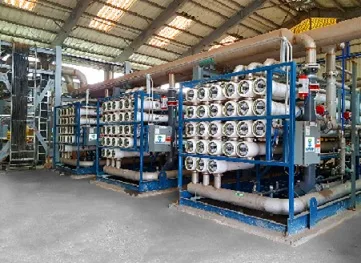To invest in sustainable construction projects, consider a reverse osmosis (RO) system for clean water solutions. Particularly, the 5-stage RO system provides highly purified water, eliminating contaminants like dissolved salts, bacteria, and chemicals, making it a reliable choice for your projects.
Understanding How Reverse Osmosis Works
Reverse osmosis, or RO, is like an exclusive VIP party for water! It’s a super effective filtration method that operates under pressure, powering water molecules through a semipermeable membrane that acts just like a microscopic sieve.
Now, this membrane is the real hero of the day. Crafted with the smallest pore structures, it permits our pint-sized water molecules to pass, while decisively blocking the entry of unwanted, larger particles.
As a result, water contaminants such as sediment, the residual chlorine, and heavy metals get stuck! They are efficiently ushered away, separated from the now pure water stream being ready to party on.
This waste gets the ‘thanks but no thanks’ treatment and is dispatched elegantly down a drain. Meanwhile, our pure, filtered water sparkles in a storage tank, awaiting its moment to shine in your use later on. So, thanks to RO, the only ones having a ball are the water molecules we need and love!
The Five Stages of Filtration Within a 5-Stage RO System
A typical 5-stage RO system works via a series of sequential filters (view many available options here) designed to progressively purify the water at each stage. This effective yet straightforward process ensures that the finished product is clean enough for various applications, including drinking and cooking. Here are the five stages of filtration in a 5-stage RO system explained:
Stage 1: Sediment Pre-filter
The first stage of any robust RO system begins with a sediment pre-filter. This filter serves as a crucial defense against large particles such as rust, sand, and sediment present in the feedwater. By trapping these larger contaminants early on, this initial stage effectively extends the life of the RO membrane found further along in the purification process.
Stage 2: Carbon Block Filter
Once sediment-laden water has passed through the pre-filter, it enters an activated carbon block filter stage. The primary function of this stage is to reduce or eliminate chlorine and other volatile organic compounds (VOCs) from the water supply. Chlorine can cause premature degradation of the RO membrane, which makes this step essential for prolonging membrane life and performance.
Stage 3: Another Carbon Block Filter
To further ensure thorough removal of chlorine and VOCs, some 5-stage RO systems include an additional carbon block filter after Stage 2. With two carbon filters working in tandem, your water quality is significantly improved before reaching the critical RO membrane stage.
Stage 4: Reverse Osmosis Membrane
This stage lies at the heart of any reverse osmosis system and provides effective filtration down to a molecular level. Here, pressurized water is forced through a semipermeable membrane made up of synthetic material with pores small enough to trap dissolved solids like salts, heavy metals, and even certain bacteria while allowing water molecules to pass through.
The result is highly purified water that has been stripped of contaminants commonly found in tap or well water sources.
Stage 5: Post Carbon Filter
The final stage typically involves an additional post-carbon filter, which serves to improve taste by removing any residual traces of chlorine, VOCs, or odors. The outcome of this process is clean, great-tasting drinking water that’s safe for consumption and free from harmful impurities.
Why a 5-Stage RO System Is the Ideal Choice for Sustainable Construction
Clean water is an essential component for sustainable construction projects, as it can promote better health and well-being within a community while reducing environmental impact.
A 5-stage RO system provides an effective means of achieving cleaner water by significantly reducing the levels of harmful contaminants prevalent in groundwater sources or local municipality feeds.
Given their impressive purification capabilities and financial efficiencies, 5-stage RO systems are fast becoming the go-to option for various industries invested in sustainable construction efforts:
- Residential Buildings: Installing whole-house 5-stage RO systems can dramatically improve water quality in upscale residential developments designed for eco-conscious homeowners. These systems provide residents with access to clean drinking water at every tap, ensuring a healthier lifestyle whilst avoiding plastic waste typically associated with purchasing bottled mineral water.
- Educational Facilities: Ensuring adequate supplies of clean drinking water within educational establishments such as schools and universities demonstrates a commitment to student health and well-being. Implementing large-scale 5-stage RO systems allows institutions to cater to the needs of thousands of students daily without compromising environmental standards.
- Hospitality Industry: Hotels and restaurants are always under pressure to maintain water quality for both consumption and hygiene purposes. Installing a comprehensive 5-stage RO system can help protect the health of guests and staff while enhancing the overall reputation of any establishment focused on sustainability.


